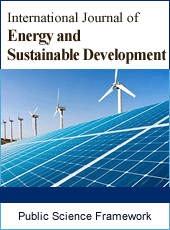International Journal of Energy and Sustainable Development
Articles Information
International Journal of Energy and Sustainable Development, Vol.1, No.1, Dec. 2016, Pub. Date: Aug. 19, 2016
Review of Existing Models for Stirling Engine Performance Prediction and the Paradox Phenomenon of the Classical Schmidt Isothermal Model
Pages: 6-12 Views: 4492 Downloads: 1407
[01]
Kwasi-Effah C. C., Department of Mechanical Engineering, University of Benin, Benin City, Nigeria.
[02]
Obanor A. I., Department of Mechanical Engineering, University of Benin, Benin City, Nigeria.
[03]
Aisien F. A., Department of Chemical Engineering, University of Benin, Benin City, Nigeria.
[04]
Ogbeide O., Department of Production Engineering, University of Benin, Benin City, Nigeria.
The Schmidt model is one of the classical methods used for developing Stirling engines. The Schmidt analysis is based on the isothermal expansion and compression of an ideal gas. However with the recent innovation in technology, the Schmidt analysis needs to be improved upon as this analysis has been found to include phenomenon which contradicts the real behavior of the Stirling engine. In this paper the Schmidt analysis used in the performance prediction of the gamma-type Stirling engine is derived and lapses in this model is identified orderly. Other popular models developed by various individuals including their assumptions and limitations are described in this paper.
Stirling Engine, Thermodynamic Model, Schmidt Analysis, Performance Prediction
[01]
Martini, W. R., (1983): Stirling engine design manual. Second edition. 1 NASA CR-168088: 79–80.
[02]
Koichi, H., (1998): Performance prediction method for Stirling Engine. Available at www.nmri.go.jp/eng/khirata/stirling/pdf.
[03]
Kongtragool, B. and Wongwises, S. A., (2003): Review of solar powered Stirling engines and low temperature differential Stirling engines. Renewable and Sustainable Energy Reviews, Vol. 7: 131–54.
[04]
Prieto, J. I and Stefanovskiy, A. B., (2003). Dimensional analysis of leakage and mechanical power losses of kinematic Stirling engines. Journal of Mechanical Engineering and Science. Vol. 217: 21-36.
[05]
Smith, A. G. and Newman, W., (2012). Analysis of hybrid fuel-cell/stirling-engine systems for domestic combined heat and power. Energy tech Vol.1: 1–7.
[06]
Toda, F. S., Iwamoto, K. and Nagajima, N., (2007). Development of low-temperature difference Stirling engine behavior of the mechanism effectiveness for the performance prediction method. Proceeding of 13th International Stirling engine Conference, Tokyo.
[07]
Chen, N. C. and Griffin, F. P., (1983). A review of Stirling engine mathematical models. Report No ORNL/CON 135, OAK Ridge National Laboratory, Tennessee.
[08]
Martinez, S., (1994). Some mathematical models to describe the dynamic behavior of the B-10 free-piston Stirling engine. Technical report. Russ College of Engineering, Ohio USA.
[09]
Malroy, E. T., (1998). Stirling model with coupled first order differential equations by the Pasic method. Technical report. Ohio University, USA.
[10]
Shoureshi, R., (1982). Analysis and design of Stirling engine for waste heat recovery. PhD Thesis, Massachusetts institute of technology (MIT) USA.
[11]
Urieli, I., (1977). Simulation of Stirling cycle machines. PhD Thesis, Witwatersrand Johannesburg, South Africa.
[12]
Roy, C. and Tew, J. R., (1983). Computer program for Stirling engine performance calculations. DOE/NASA/51 040-42 NASA TM-82960. Available at http://ntrs.nasa.gov/archive/nasa/casi.ntrs.nasa.gov/19830009152.

ISSN Print: Pending
ISSN Online: Pending
Current Issue:
Vol. 4, Issue 2, June Submit a Manuscript Join Editorial Board Join Reviewer Team
ISSN Online: Pending
Current Issue:
Vol. 4, Issue 2, June Submit a Manuscript Join Editorial Board Join Reviewer Team
| About This Journal |
| All Issues |
| Open Access |
| Indexing |
| Payment Information |
| Author Guidelines |
| Review Process |
| Publication Ethics |
| Editorial Board |
| Peer Reviewers |


